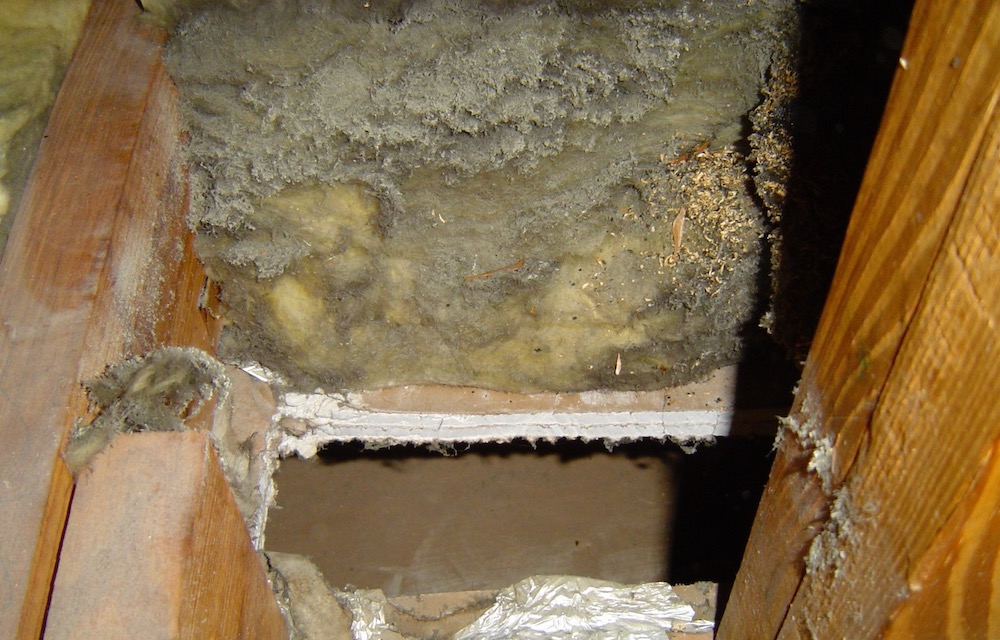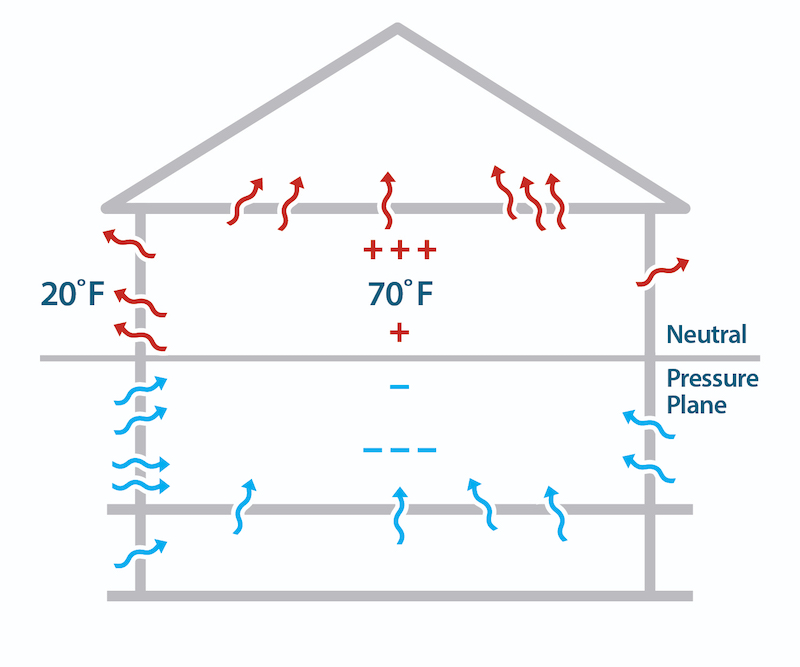What’s the Deal With Exfiltration?

When you first start learning building science, you may run into this thing called exfiltration. It’s not a widely used word, even among those of us who work in the world of building science. We learn about it and then mostly don’t use it. So why learn about it at all? Is it not important?
What is exfiltration?
Air is a wonderful thing, but it can be hard to grasp. Just try. Grab a handful, close your fingers around it, and it’s gone. Its behavior in buildings is our main interest here, and there a few basic rules. The one that matters most to this discussion is that the air leaking into a house will be matched by an equal amount of air leaking out.
We call the air leaking into the house infiltration, and the air that leaks out is exfiltration. Makes perfect sense, right? You may have felt both sides of this air leakage without realizing the difference. In an old house, for example, you can stand next to a leaky door or window and feel a cold draft in winter as infiltration brings that cold outdoor air inside. The most dramatic example of exfiltration is that whoosh of warm air you feel when you go up the attic stairs on a cold day and then look down into the house from above.
The stack effect and exfiltration
One place where it makes a lot of sense to talk about exfiltration is with the stack effect. Warm air rises in a house. If there are air leakage pathways in the building enclosure, air leaks in below the neutral pressure plane and out above the neutral pressure plane. So, we get infiltration below the neutral pressure plane and exfiltration above it.

More about exfiltration
One of the other rules of air leakage is that air moves from high pressure to low pressure. Exfiltration means air is moving from inside to outside, so the part of the house that’s exfiltrating is at a higher pressure than the air on the other side of the floor, wall, or ceiling that it moves through.
Those positive pressure areas can arise from more than just the stack effect. Just closing a door can create a positive pressure in a bedroom if there’s not an adequate return air pathway. The condo I used to live in would develop a significant positive pressure in one bedroom with the door closed and air handler running. The air being pumped in there had to go somewhere, so a good amount of it exfiltrated.
![Wind creates positive and negative pressures, which result in infiltration and exfiltration [Image courtesy of The Energy Conservatory]](https://www.energyvanguard.com/wp-content/uploads/2022/12/wind-pressure-positive-negative-800.jpg)
Does this even matter?
The way we talk about building science phenomena does matter. If you call Tyvek Home Wrap a vapor barrier—and some do—you’re not only incorrect, but you confuse other people. If you refer to all air leakage as infiltration—and I’ve heard this, too—you’re also giving others bad information. The total air leakage in a house is a combination of infiltration and exfiltration.
It also matters because infiltration and exfiltration have different effects. Infiltration can bring in unconditioned air, humidity, and pollutants. Exfiltration sends conditioned air and moisture out of the house. Both flows often travel through interstitial spaces, though, and can cause problems along the way. If you have a building cavity with a sweating supply duct in summer, for instance, infiltration may be the problem. Exfiltration of indoor air into a wall cavity can cause moisture problems on exterior sheathing.
All this is really important when you’re trying to solve building performance problems. When we do consulting jobs, we often have examine which way the air is flowing so we can figure out if that could be the source of the problem. If you’ve heard Dr. Joe Lstiburek speak, you may have heard the story of how he proved that the US Congress sucks. He went into one of the tunnels beneath the complex and found a huge rush of air flow toward the Capitol.
In short, the total amount of air leakage is important, but so is the direction of that air flow.
Allison A. Bailes III, PhD is a speaker, writer, building science consultant, and the founder of Energy Vanguard in Decatur, Georgia. He has a doctorate in physics and writes the Energy Vanguard Blog. He also has written a book on building science. You can follow him on Twitter at @EnergyVanguard.
Related Articles
The Ol’ Beer Can Pressure Crunch
Is Negative Pressure Causing a Problem in Your Home?
The 3 Rules of Air Leakage (Plus a Bonus!)
Comments are moderated. Your comment will not appear below until approved.
This Post Has 4 Comments
Comments are closed.

Great topic and photo. Next time you open the door to a residence, open it gradually and pay attention to how much air is moved through the door. Dependent upon the prevailing wind you may get air passing you to enter the dwelling, or you may experience a gust in your face. Either way, this air movement is relative to the paths for leaky conditions that lead to exfiltration and infiltration.
I love this article! Not only am I dealing with these specific issues in my own home, I have become a building science enthusiast because of it. Not to mention wanting to soak in every detail Mr. Alison Bailes writes about as he digs deep into the infiltration and exfiltration of the air quality world. It is a science, and a science with very real and strange consequences at best. My home being the proof of inhaling and exhaling everything from cellulose insulation to building materials and pollution. Thank you Mr. Alison Bailes for these great posts about the science of buildings, the air we breathe, and the fascinating ways in which it all works.
is stack effect significant at bathroom vent ducts, dryer vent too? Seems solving these would be “low hanging fruit”. Eliminate dryer vent with heat pump dryer or reduce with Heartland 21000 vent cap (like upside down coffee can in housing). For bathroom vent, 1 or 3 slotted vent exit gets blown open by wind so less effective.
Is it still exfiltration if the air never makes it all the way through the wall assembly?
My question reminds me that I always thought it made sense (in theory) to have at least two air barriers…one on the inside and one on the outside.
When I see Rockwool insulation added to the outside of exterior sheathing, I wonder what the wind does to the effective r-value. Likewise, when I see zip-wall as the air barrier, and less details on the drywall, I wonder what air currents are going on inside the wall assembly from stack effect pressures.